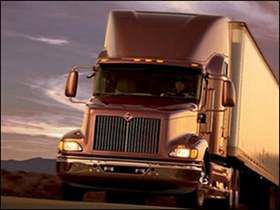Review Questions - Click On The Picture To Begin...

- Hazardous liquids can only be carried in a tanker truck
- Hazardous material shipping papers must be kept in the glove box at all times
- Not all hazardous material loads require placards
- Any amount of hazardous cargo requires a hazardous material license endorsement
Quote From The CDL Manual:
Not all vehicles carrying hazardous materials need to have placards.
- In the front storage box or glove box
- In clear view within reach while driving
- In a pouch on the passenger side door
- Inside a folder and placed on the dashboard
Quote From The CDL Manual:
Shipping Papers After an accident or a hazardous material spill or leak, you may be injured and unable to communicate the hazards of the materials you are transporting. Firefighters and police can prevent or reduce the amount of damage or injury at the scene if they know what hazardous materials are being carried.
Your life, and the lives of others, may depend on quickly locating the hazardous materials shipping papers. For that reason, you must tab shipping papers related to hazardous materials, or keep them on top of other shipping papers. You also must keep shipping papers:
- In a pouch on the driver's door, or
- In clear view within reach while driving, or
- On the driver's seat when out of the vehicle
TruckingTruth's Advice:
The Department of Transportation is extremely strict about these guidelines. If you plan on carrying any type of hazardous materials, be certain to follow these rules regarding where shipping papers are to be kept.
Even if you aren't planning on acquiring a hazardous materials endorsement or carrying any hazardous material loads, you are still required to have basic knowledge about hazardous material regulations. Questions like this are likely to show up on your written exam.
- Front, rear, and both sides of the vehicle
- Rear and both sides of the vehicle
- Front and rear of the vehicle
- Front, rear, both sides, roof, and underneath the vehicle
Quote From The CDL Manual:
Placards are used to warn others of hazardous materials. Placards are signs put on the outside of a vehicle that identify the hazard class of the cargo. A placarded vehicle must have at least four identical placards. They are put on the front, rear and both sides. Placards must be readable from all four directions. They are 10 3/4-inches square, turned upright on a point, in a diamond shape. Cargo tanks and other bulk packaging display the ID number of their contents on placards or orange panels.
TruckingTruth's Advice:
Even if you are not planning on obtaining your hazardous materials endorsement, some various general knowledge questions will be asked about hazardous cargo.
- Inside the glove compartment
- In a pouch on the driver's door
- In clear view within reach while driving
- On the driver's seat when out of the vehicle
Quote From The CDL Manual:
Shipping Papers After an accident or a hazardous material spill or leak, you may be injured and unable to communicate the hazards of the materials you are transporting. Firefighters and police can prevent or reduce the amount of damage or injury at the scene if they know what hazardous materials are being carried.
Your life, and the lives of others, may depend on quickly locating the hazardous materials shipping papers. For that reason, you must tab shipping papers related to hazardous materials, or keep them on top of other shipping papers. You also must keep shipping papers:
- In a pouch on the driver's door, or
- In clear view within reach while driving, or
- On the driver's seat when out of the vehicle
TruckingTruth's Advice:
The Department of Transportation is extremely strict about these guidelines. If you plan on carrying any type of hazardous materials, be certain to follow these rules regarding where shipping papers are to be kept.
Even if you aren't planning on acquiring a hazardous materials endorsement or carrying any hazardous material loads, you are still required to have basic knowledge about hazardous material regulations. Questions like this are likely to show up on your written exam.
- All of these answers are correct
- Require a special license endorsement when transported in large quantities
- Require special load securement and containment
- Pose a risk to health, safety, and property during transportation
Quote From The CDL Manual:
All drivers should know something about hazardous materials. You must be able to recognize hazardous cargo and whether or not you can haul it without having a Hazardous Materials Endorsement added to your CDL license.
Hazardous materials are products that pose a risk to health, safety and property during transportation.









 TT On Facebook
TT On Facebook